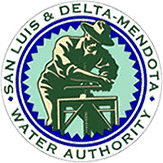California's Central Valley
Delta-Mendota Canal: Using Groundwater Modeling to Analyze Land Subsidence
A numerical modeling approach is being used to quantify groundwater conditions and land subsidence spatially. In addition, selected management alternatives for controlling land subsidence will be evaluated. The numerical modeling will consist of four main tasks:
Task 1: Develop a one-dimensional (1-D) vertical coupled groundwater-flow and land subsidence model to identify the major fine-grained units that control compaction in a selected area along the DMC and to evaluate the vertical discretization needed to adequately simulate compaction in the Corcoran Clay in a regional groundwater-flow and subsidence model.)
The focus of the model will be the role of the fine-grained deposits, both the thick and the thinner interbedded aquitards, in aquifer-system compaction. The simulation of aquifer-system compaction is based on the established theory of aquitard drainage (Helm, 1975) and will be used in 1-D simulations of coupled groundwater flow and skeletal deformation based on the elastic and inelastic compressibilities of the aquifers and the aquitards (Hoffmann and others, 2003). The coupled model solves for hydraulic head and vertical displacement for specified aquifer-system properties as a function of depth and time. The model will permit a detailed analysis of the processes controlling compaction and also will be used to evaluate sub-regional model construction, particularly the vertical discretization of the Corcoran Clay.
Task 2: Utilize the recently developed regional 3-D Central Valley Hydrologic Model (CVHM) (Faunt, 2009) to assess alternative projects or policies as well as testing the development of additional supply and storage alternatives, increased conservation and efficiencies, or increased water reclamation or reuse.
The CVHM will be used to predict the effects of an extended drought on water levels and land subsidence along the DMC. The model will provide useful insight into the relation between conveyance along the Canal, land subsidence, and the water supply and demand components of agriculture and urban water uses. Simple hydrologic assumptions of drought conditions and reduced deliveries will be used to help forecast the anticipated location and magnitude of land subsidence along the Canal and surrounding area. Additional model scenarios will be completed to simulate the effects of reduced surface-water deliveries, in addition to the regional drought. The results of these scenarios will be analyzed for water levels and land-subsidence data for the simulation period.
Task 3: Update and rediscretize the CVHM in the area along the Delta-Mendota Canal to better simulate groundwater levels and land subsidence.
Update, rediscretize, recalibrate, and add additional details to the CVHM with direct reference to the area of interest and (or) the ability to simulate subsidence in more spatial detail. These enhancements will provide more detailed answers to the cause and effect relations of groundwater pumping and land subsidence. Because the CVHM is a regional model developed for the Central Valley as a whole, it is spatially too coarse to be used to evaluate site-specific and sub-regional flow and subsidence conditions. The CVHM will be updated and refined in the study area to provide an improved understanding of the relationship between groundwater pumping and land subsidence. The San Joaquin Valley and Delta portions of the CVHM will be spatially rediscretized. The updated and refined model will be used to simulate the drought scenarios described in Task 2. The updated model will more accurately forecast the anticipated locations and magnitudes of land subsidence. The model results will be analyzed relative to the water use, land subsidence, and Canal structures for this period. The effects on the Canal will include the impacts of land subsidence on changes in land-surface elevations that affect Canal gradients and freeboard capacity. .
Task 4: Utilize the updated/rediscretized CVHM to examine several management alternatives.
The updated/rediscretized CVHM will be used to address adaptation and mitigation alternatives to changing climate and reduced surface-water deliveries. The task will analyze the effect of changing water demand and supply on various subregions along the Delta-Mendota Canal. The USGS will work with the San Luis and Delta-Mendota Water Authority to develop potential water-management alternatives to evaluate with the CVHM.


